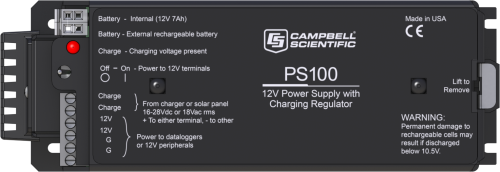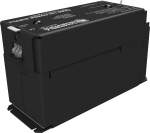This product is not available for new orders.

| Services Available | |
|---|---|
| Repair | No |
| Calibration | No |
| Free Support | No |
Overview
The PS100 provides a 12-Vdc, 7-Ah rechargeable power supply for the CR500, CR510, CR800, CR850, CR10, CR10X, and CR1000 dataloggers and peripherals. The rechargeable battery can be trickle-charged from ac power (requires optional wall charger) or from an external solar panel. The user can add an external rechargeable battery.
Read MoreTechnical Description
The PS100 can also be used as a separate auxiliary 12-V power supply to power remotely located sensors or peripherals, such as a multiplexer located at a distance from the datalogger enclosure. However, to avoid errors in analog measurements and ground loops, the power supplies must share a common ground.
Images








3D/CAD Files:
Related Products
Compatibility
Please note: The following shows notable compatibility information. It is not a comprehensive list of all compatible products.
Dataloggers
| Product | Compatible | Note |
|---|---|---|
| CR1000 (retired) | ||
| CR200X (retired) | ||
| CR216X (retired) | ||
| CR3000 | Typically, a CR23X, CR3000, or CR5000 datalogger uses its integrated rechargeable base instead of the PS100. However, the PS100 can be used if the data logger has a low-profile base or if the battery base has been disconnected. | |
| CR5000 (retired) | Typically, a CR23X, CR3000, or CR5000 datalogger uses its integrated rechargeable base instead of the PS100. However, the PS100 can be used if the data logger has a low-profile base or if the battery base has been disconnected. | |
| CR6 | ||
| CR800 (retired) | ||
| CR850 (retired) | ||
| CR9000X (retired) |
Miscellaneous
| Product | Compatible | Note |
|---|---|---|
| 34029 |
Additional Compatibility Information
Enclosure Considerations
A desiccated, non-condensing environment is required. The PS100 includes built-in keyhole flanges for mounting to the backplate of a Campbell Scientific enclosure.
Adapters
The PS100 is compatible with the A100 null-modem adapter and the A105 adapter for additional 12 V output terminals. The A100 Null Modem Adapter connects and powers two Campbell Scientific peripherals via two CS I/O 9-pin connectors configured as a null modem. This is useful in linking different communications technologies, such as telephone to radio, at sites that do not have a data logger. The A105 adapter may be used to provide additional 12 V and ground terminals where the power supply is used to power several devices.
Charging Source
The PS100 charges with a 24 V input. However, when the battery is discharged or the system is pulling high current (about 700 mA), the regulator overheats. This, in turn, limits the charging time because the regulator is heating up until it gets so hot that it shuts down. At this point, the regulator stops charging the battery until the regulator cools down and starts charging again. This cycle repeats until the battery is charged enough so that the regulator no longer overheats. For a system with a constant current drain of 0.7 A or higher, the PS100 is not able to keep the battery charged unless the input voltage is between 16 and 20 V. If the input voltage is between 16 and 20 V, the regulator outputs continuously up to a 1.2 A load.
Specifications
| input Voltage (CHG Terminals) | 15 to 28 Vdc or 18 Vac RMS |
| Charging Output Voltage | Temperature compensated float charge (for 12 V battery) |
| Output Limit (12V and G Terminals) | 3.0 A (temperature dependent) |
| Charging Current Limit | 1.2 A (typical) |
| Power Out (+12 Terminals) Voltage | Unregulated 12 V (from battery) |
| Nominal Rating | 7 Ah |
| Dimensions | 10.5 x 19.3 x 7.1 cm (4.1 x 7.6 x 2.8 in.) including mounts and connectors |
| Weight | 3.1 kg (6.9 lb) |
| Battery Weight | 2.7 kg (5.9 lb) |
Quiescent Current |
|
| Charge Source Present | 3 to 5 mA |
| No Charge Source Present | 0 mA |
Resources and Links
Technical Papers
Videos & Tutorials
FAQs for
Number of FAQs related to PS100: 31
Expand AllCollapse All
Case Studies
The city of Frisco, Texas, sits in an area that experienced severe drought from about......read more
The city of Frisco, Texas, sits in an area that experienced severe drought from about......read more
Korea Expressway Corporation (KEC) was established in 1969 to construct and manage expressways throughout South......read more
The Solar Decathlon takes place every other year on the National Mall in Washington, D.C.......read more
The Mount Washington Observatory in New Hampshire is one of the oldest weather observatories in......read more
Articles and Press Releases
Privacy Policy Update
We've updated our privacy policy. Learn More
Cookie Consent
Update your cookie preferences. Update Cookie Preferences




